
How often have you bought something after seeing an influencer share it on social media, or checked out a brand you saw a celebrity wear? That’s the power of influencers.
Influencers, sometimes called ‘key opinion leaders’, have made a career out of building an audience and creating content that excites them. For ecommerce brands, influencer marketing campaigns can be a powerful tool to drive awareness and conversion.
A Mediakix survey found that 90% of marketers rated influencer marketing delivered ROI equal to or better than other marketing channels.
In this article, we’ll look at the 4 key steps to run an effective influencer marketing campaign.
An influencer is anyone with a sizable following on one or more social platforms. When brands approach influencers to promote their business, that’s influencer marketing.
Influencer marketing can take many forms, but they are effectively a partnered marketing campaign between the brand and influencer. It could be as casual as a one-off Instagram post tagging the brand, to more involved collaborations like naming the influencer a brand ambassador, to an involved business partnership, like launching a co-branded product.
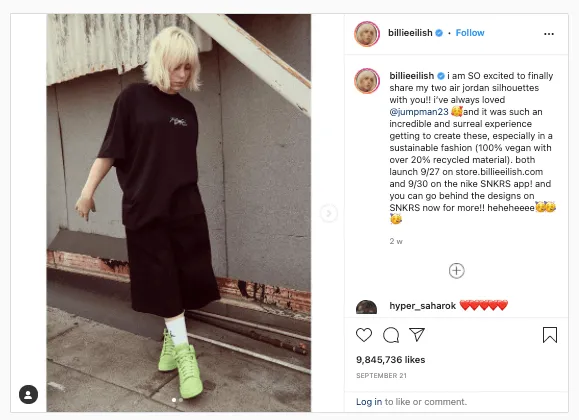
Musical superstar and influencer Billie Eilish launched two co-branded products with Nike Air Jordans.
Influencer marketing campaigns can take various content forms and appear across various social platforms, which is why planning is important.
You can break down most influencer marketing campaigns into four simple steps:
We’ve also loaded up our guide with plenty of tools and examples. Let’s get to it.
Setting campaign goals is the most important step; it affects the type of influencers you recruit, how you measure success, and what kind of content you’ll co-create.
Influencer marketing campaigns can be categorized into several broad goals:
The more precisely you can define your goals, the easier the remaining campaign will be. Some questions you can ask to clarify your goals are::
Let’s look at two campaigns with different goals: HelloFresh making a bid for maximum brand awareness across all platforms, and Alo Yoga focusing exclusively on Instagram for the #AloChallenge.
HelloFresh is a meal-kit subscription service that’s grown from strength to strength since the pandemic.
HelloFresh set its sight on world domination with its influencer campaign - and we’re not exaggerating. The top #HelloFresh posts on Instagram come from the U.S., Sweden, Canada, Australia, and more:
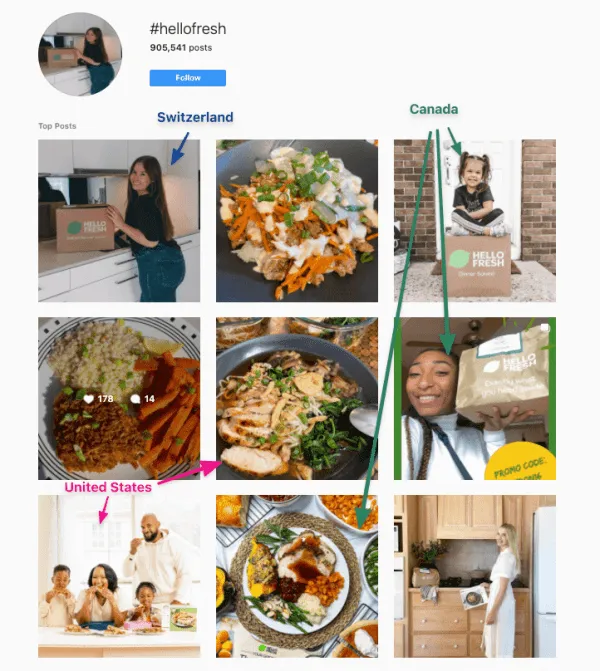
World domination from #HelloFresh
HelloFresh is partnering with all kinds of influencers as well, from mommy bloggers to young college students and even fitness gurus.
And it’s not just on Instagram; chances are, you’ve heard a HelloFresh ad on a popular podcast, or come across a sponsored review on YouTube:
https://www.youtube.com/watch?v=_pemozMjuwM
In contrast, the #AloChallenge is tightly focused on the Instagram platform. Popular athleisure brand Alo Yoga runs a weekly themed #AloChallenge, led by five yoga pros to engage its community on Instagram.
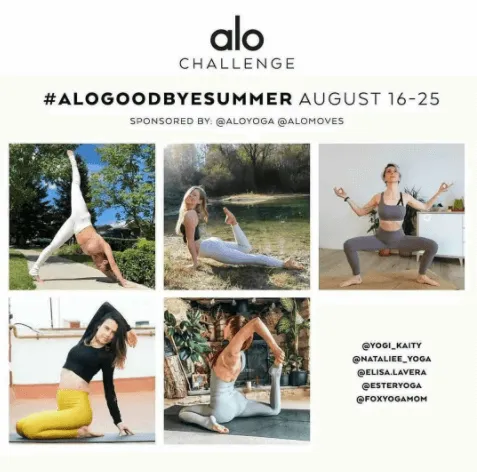
Alo Yoga’s earned media channel
There are no prizes to be won; it’s just a personal challenge you participate in and maybe tag your friends. For Alo Yoga, it’s a great way to engage the community, and keep the brand active on Instagram, one of its most important marketing channels.
Defining your campaign goals will make it easy to identify the types of influencers to recruit for your campaign - and allocate the appropriate budget.
RECAP:
Each influencer has cultivated a following of a certain size, demographic, and interest. The perfect influencer has an audience that fits directly into your target market - which is why you want to choose influencers carefully. Staying informed about current trends for influencer strategy can also guide your selection, helping you align with influencers whose content and engagement styles reflect evolving audience expectations.
For example, if you’re running a campaign for a flashy supercar, you probably want to target luxury lifestyle bloggers, instead of budget travelers and mommy bloggers.
One of your first considerations should be the type of influencers you’re reaching out to, how big their followers are, and how much they will cost. Broadly speaking, these are the terms that describe influencer tiers:
Note that these are rough estimations since the industry is still growing and definitions shift.
It’s useful to break down influencers by the size of their audience because that affects the rate they charge. To give you an idea, here are some benchmarks from Influencer Marketing Hub: but note that numbers may vary depending on geography, whether the influencer has an agency, or whether or not they like your brand:

Data from InfluencerMarketingHub
But size is not the only thing that matters; another aspect to consider is also the influencer’s engagement rate.
Once again, it depends on your brand objectives. If you’re looking for reach and brand awareness, you can’t go wrong with mega-influencers with a huge following. With a single Facebook post, Kendall Jenner reached over 22 million followers.
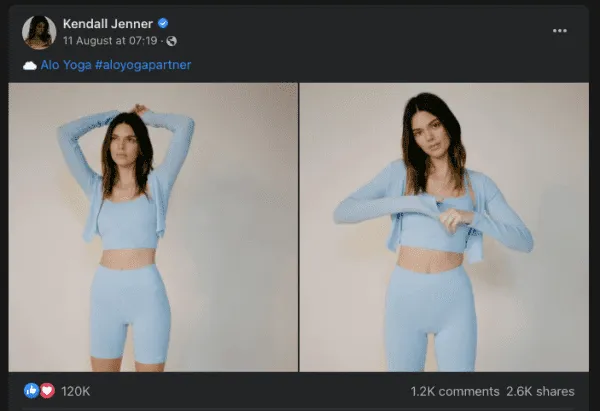
Alo Yoga going for broad brand awareness
But with greater reach comes poorer audience engagement; Kendall’s post works out to an engagement rate of about 0.5%. Smaller influencers tend to have a better engagement rate, because of the closer relationship they’ve built with their audience.
@leahsfieldnotes is a Canadian student blogger with a comparatively tiny 160,000 following on Instagram, yet her engagement rate is close to 40x that of Kendall Jenner’s:

Calculated using Phlanx’s Instagram engagement tool
Upfluence found that micro-influencers have better engagement rates than social media superstars. Phlanx corroborates this, with this graphic benchmarking Instagram engagement rates:

This may be because micro-influencers are closer to the audience, respond and interact more often, and feel more authentic. That might make micro-influencers a better choice for endorsing your product, and be lower-cost too.
To see examples of success with both mega-influencers and nano influencers, check out our list of examples below. [Jump link below]
Authenticity is at the heart of any influencer marketing campaign. You want to partner with an influencer who is aligned with your brand values - after all, your brand will be associated with them.
There’s no better way to check the authenticity of influencers than to do some organic screening. Scroll through the influencer’s profile and content to get a sense of their audience and the image they present. Here are some great questions to ask.
Elsewhere on the blog, we’ve covered 5 ways to screen for influencers, but here are some additional questions to ask yourself:
There are plenty of tools and sources for finding influencers online, so we won’t go into too much detail. But we have some ideas and recommendations:

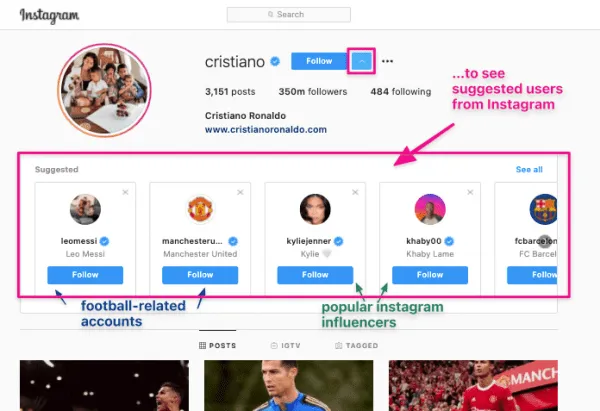
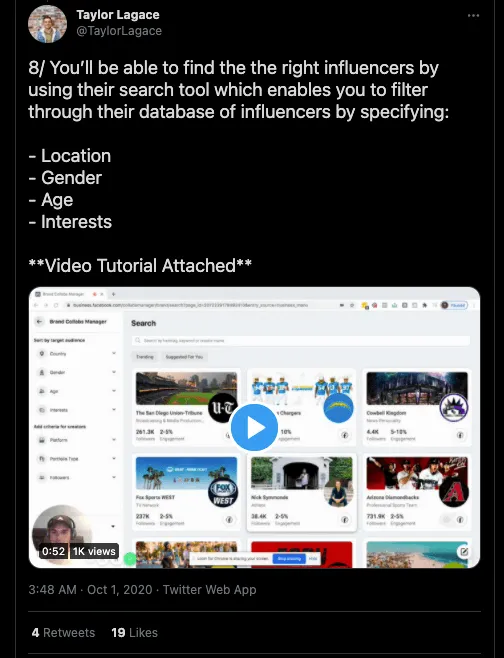
We follow @TaylorLagace for influencer marketing insights
(If you are looking for micro-influencers for your brand, we are building a tool to help you. Sign up for early access!)
You want to find influencers who take their job seriously and are authentic. If not, you might end up with this situation.
In 2016, reality TV star Scott Disick was reportedly paid a five-figure sum to make a post for BooTea Shake. Instead, he simply uploaded an image and copy-and-pasted the caption, which included instructions telling him when to make the post:
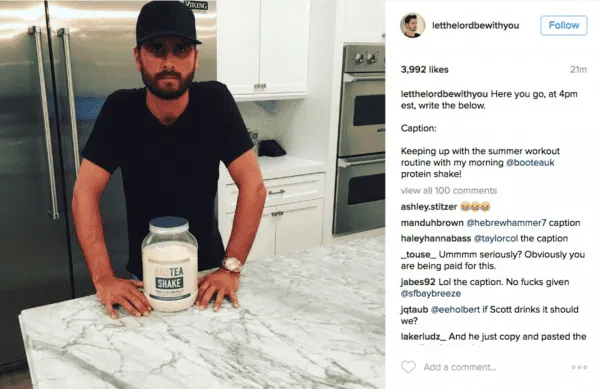
He quickly corrected his mistake, but the damage to BooTea Shake’s reputation was done. The brand was mentioned all over the internet and press, but for all the wrong reasons - and I bet sales didn't exactly go up either.
Once you decide on a list of relevant influencers, it’s time to reach out to them.
RECAP:
The process of recruiting and onboarding influencers is a crucial step. It serves as the start of your professional relationship with the influencer and can be useful to settle disputes in the future.
Before starting your outreach, you may want to draft these three things. You’ll want:
You can send your outreach through various mediums - emails, DMs, or leaving a comment on their posts.
Some influencers prefer DMs to emails, because that’s where they spend most of their time dealing with collaborators. The next section features a successful approach using DMs only.
One pro-tip we saw while researching this article was to look out for influencers with a contact email in the profile, because:
We recommend trying all three to see what works for your industry and audience.
With an outreach template, you can send outreach messages at scale to many influencers. Start with a simple template, and personalize each one to the influencer you’re reaching out to. Here’s an example of a successful approach by a DTC brand.
Joanne Coffey, Head of Retention at Aisling Organics, shared a tweetstorm where she shared how she approached two Tik Tok influencers with over 500,000 combined followers. She engaged with their content for two weeks straight before using her personal Tik Tok account to approach them, with an earnest, heartfelt outreach:

Read the full thread on Twitter
They both responded within 8 minutes and agreed to feature Aisling Organics for free. Once again here, authenticity is the key.
Here are some other key details you should include in your outreach template:

And it might look something like this:
Hi [name of influencer],
I am [your name] from [your company], and we're interested in working with you on a marketing campaign focusing on [explain what the campaign is about].
We think you would be a great fit, and your audience because:
<Explain why you think the influencer is suitable. Keep it to a maximum of 3 liners.>
I would love to discuss this in greater detail and answer any questions you may have.
[Next steps for how the influencer should take this forward]
Thank you,
[your full name]
[other contact details]
[link to the store]
For more inspiration, we recommend these three articles for more examples and guidelines.
A clear and well-structured brief will help to keep your collaboration organized. If your influencer is working with many brands, your brief will help them figure out what content to post and track when to post it. The brief can also be useful if there’s a dispute in the future.
Here are 6 elements that should be present:
Creative, compelling content works best. There are plenty of brands working with influencers out there, and over time, audiences will start to skim past the obviously sponsored posts.
Some influencers may be happy to brainstorm ideas, rewrite the script, or suggest interesting ideas to showcase the brand. Here are some influencer campaigns we liked:
SozyBabes collaborates with nano-influencers
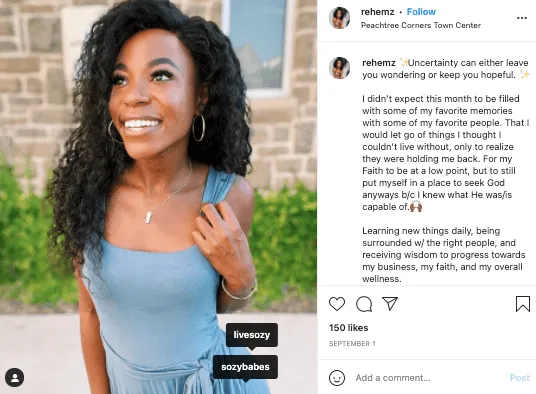
An authentic post from @rehemz - she may be a brand ambassador, but it doesn’t feel like a sponsored post or a paid advertisement.
Sozy is a female-founded brand from California, with a focus on ecological impact and empowering women. 20% of profits are pledged to causes like supporting survivors of sexual violence and other charitable/environmental initiatives.
Unlike other fashion brands, Sozy scouts nano-influencers from 4,000- 8,000 followers for its SozyBabes brand ambassador program. VP of Growth, Marquis Matson commented:
“We target smaller influencers for our ambassador program and they’ve actually been incredible. They are the most active on our social media accounts, some of our best customers, and they regularly share and tag @livesozy just because they are genuinely jazzed to be part of the community.”
“Our SozyBabes are great for many reasons, but the main one is the community they bring. They’re very active on our social channels - the dream for any brand.
“We also regularly ask them for input on designs, blog topics, and the business in general. This helps us keep really good communication with our target market.”
Marquis also shared that their ambassador program runs for a surprisingly low budget, but has resulted in a 30-40% increase in engagement for the brand.
MY TAKEAWAY: Choose the right influencers to meet your campaign goals. The SozyBabes may only have thousands of followers, but they are bringing authenticity and real engagement to the brand.
Martin’s Potato Rolls gets a starring role in a Burger Scholar recipe
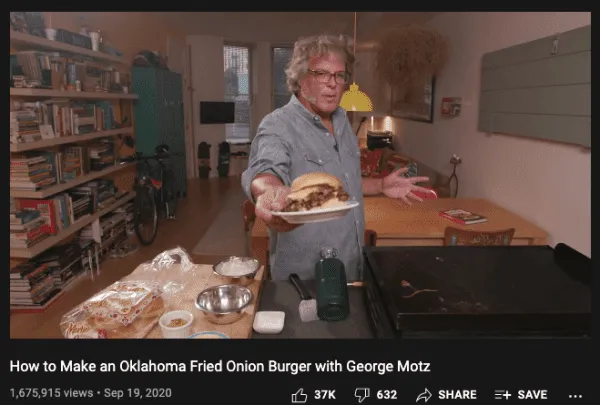
One million views on YouTube!
‘Burger Scholar’ George Motz loves burgers, and regularly creates videos showing how to cook specialty burgers from all around America. His goofy personality and love of burgers earn him a million views on each video.
Martin’s Potato Rolls hit on a mouthwatering way to showcase the brand, by having George create a unique recipe featuring the Rolls as the core ingredient of the bun. You can bet George Motz fans - who are also burger fans - will be eager to try out
MY TAKEAWAY: Content succeeds when your brand’s customers overlap with an influencer’s target audience.
Puma cross-promotes athletes with cross-training videos
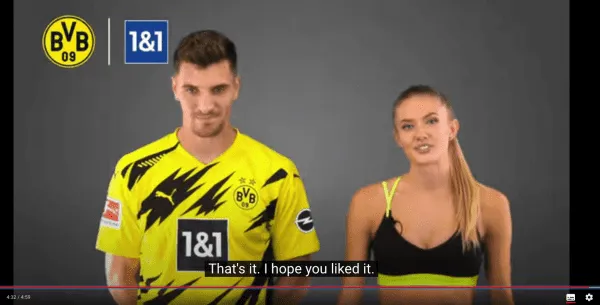
Watch Stay Fit! on YouTube
German sportswear brand Puma sponsors athletes around the world. In 2021, they launched Stay Fit, a video series introducing simple exercises anybody can perform.
The series features German fitness influencers: footballers from team Borussia Dortmund, Olympic sprinter Alica Schmidt, singer-dancer Fernanda Brandao, and fitness influencer Pamela Reif. These are recognizable names in Germany, but not internationally and not nearly as famous as global superstar Cristiano Ronaldo.
Even so, the series is a success in their target market in Germany. Each video gets just under a million views, and there’s an interesting angle: you see which exercises make footballers sweat, and which are tough for runners to do.
The real winner is Puma, which establishes itself in Germany as the brand top local athletes wear, whatever sports they play.
MY TAKEAWAY: You don’t have to go for the global superstars - local influencers and celebrities can be equally effective if you have a creative angle.
YouFoodz takes over Australian Instagram
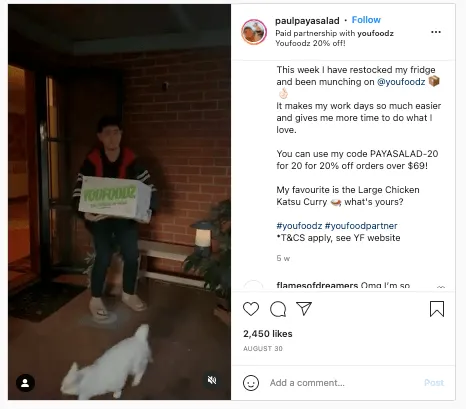
@paulpaysalad is an Australian lifestyle & food blogger
If you’re in Australia, chances are you’ve seen YouFoodz in your social feed at some point in the last 3 months. YouFoodz has been sponsoring influencers all over Australia and offering hefty discounts with unique codes.
From rugby players to mummy bloggers, to content creators focusing on lifestyle, makeup, and fashion, Australian influencers are flooding Instagram with 20% off codes and featured posts. Obviously, this takes a hefty budget - but it also reinforces the idea that YouFoodz can be for anybody.
MY TAKEAWAY: While browsing the #YouFoodzpartner tag on Instagram, I noticed that each post is a couple of days apart. If it’s deliberate, it’s a good idea - spacing out the posts means that audiences won’t feel overwhelmed by YouFoodz posts, but still, have regular servings of sponsored content.
And one counter-example:

Cristiano Ronaldo does not talk like that.
Soccer superstar Cristiano Ronaldo is the most followed man on Instagram, with over 300 million followers. Yet, he’s appeared in ads for everything from suitcases to Kentucky Fried Chicken to shampoo.
This post feels boring and inauthentic; the caption was clearly written by someone in marketing. The post still works and got 17 million views, but also feels like a missed opportunity to do something creative with Ronaldo.
RECAP:
After the campaign, it’s important to evaluate the metrics to see if your influencer campaign reached its goal. Here are some suggested metrics based on your campaign goals:

The success of your influencer marketing campaign depends on the goals you set up in Step 1 of this guide. Here’s are three approaches to measuring and quantifying success:
If the influencer campaign goes well, you should notice an immediate uptake in sales or traffic. One pro tip is to use Google’s Campaign URL Builder to include UTMs, to distinguish between multiple campaigns and different influencers.
If you’re using a tool like ReferralCandy or affiliate programs to identify sales, these tools will also have individual dashboards to report sales or link clicks. Influencer marketing should not be your only customer acquisition channel, and you want to isolate the effect of each campaign.
ReferralCandy also tags traffic from referral links, so you can view this in Google Analytics.
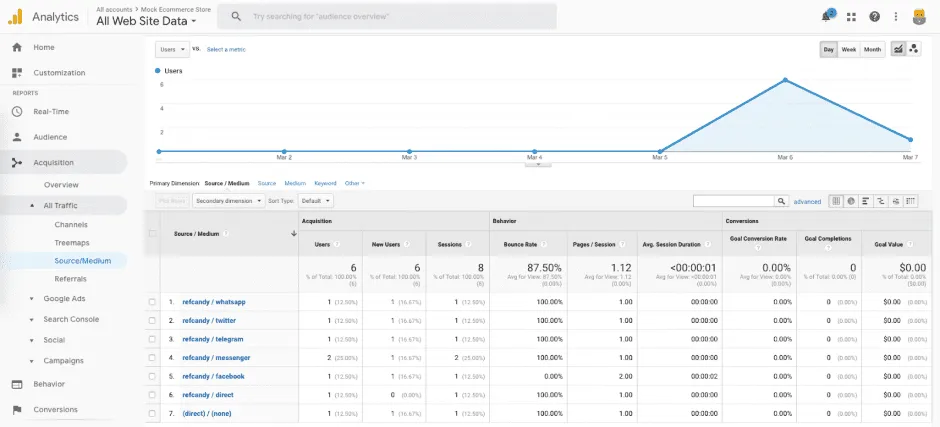
Read more: Google Analytics for Ecommerce
Before you launch your campaign, you may want to make sure your brand profile is a business account. You’ll get additional insights about the performance of your brand, including new followers, profile views, and additional views/engagement with your posts.
Each platform has a slightly different name, but here are the guides to set up
There are also many social media monitoring tools you can use to monitor the growth of your social media account - you may already be using these to manage and post. We have two additional tools to recommend: MightyScout and #paid.
We first heard about MightyScout from a tweetstorm by Taylor Lagace where he shared how he scaled Animal House Fitness from $0 to $4m in just four months. Taylor used MightyScout to identify influencers who were posting about the brand and reached out to collaborate with them on a campaign.

MightyScout collects influencer data and media based on the accounts, @mentions, or hashtags used in posts and stories. It’s especially helpful to collect content that’s being organically posted in real-time.
#paid is another popular option for influencer marketing campaigns.
(As an aside, we’re also big fans of #paid’s Banknotes, which publishes useful insights on influencer marketing trends, interviews with influencers.)
There are also many free analysis tools out there to explore. We’ve mentioned Phlanx before, and InfluencerMarketingHub also has a useful tool to check the follower growth for your brand:
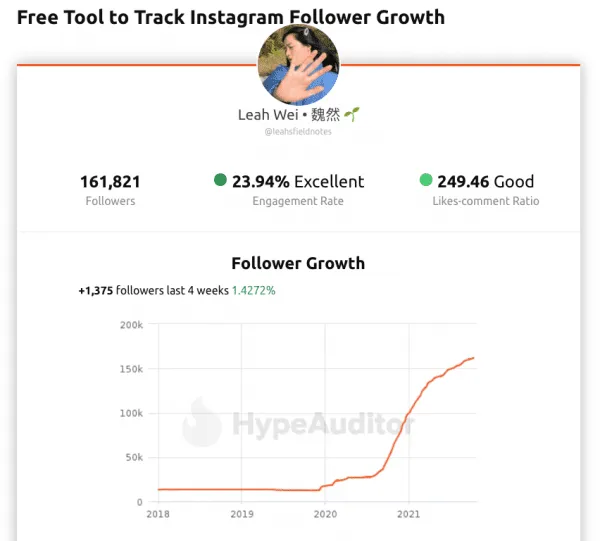
A helpful growth curve. Via InfluencerMarketingHub
It also provides a useful calculation of the Engagement Rate and Likes-Comment ratio, which is also helpful when you’re scouting for new influencers.
As part of your campaign brief, you can request the influencer send you a screenshot or report of the insights after they post (usually after 24-48 hours). This can help you identify your most valuable influencers and whether to work with them again.
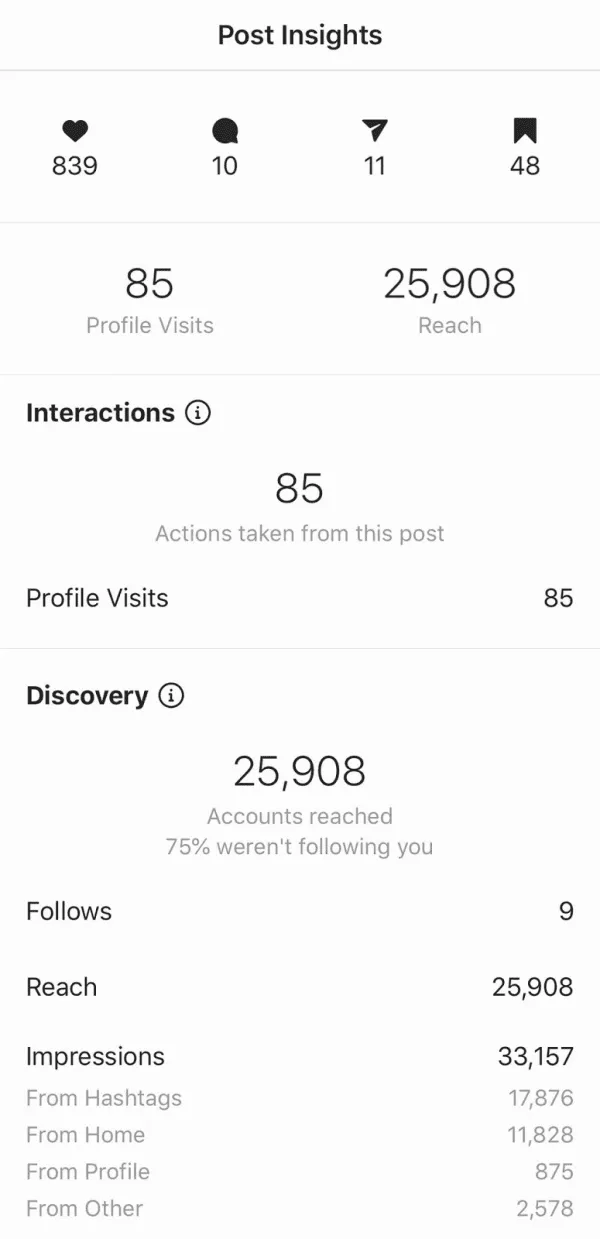
Good reach, but poor engagement. Example from Invideo.io
In this example, I might choose to work with the influencer again for brand awareness, but not for engagement or conversion. The post reached 25,000 accounts, but resulted in relatively low engagement - just 0.3% of users went on to check out the profile, made a comment, or sent a DM.
YouTube offers creators insights like views, reach, watch times, and audience demographics. For Facebook and Instagram, influencers will need to have Creator accounts to see insights.
To delve deeper into what stats are available to the creator accounts, you can read these reference articles:
RECAP:
We hope this guide has helped you to plan an effective influencer marketing campaign from planning, and execution to review. Each step in the campaign planning is very important as it all adds up to collective success.
Influencer marketing is all about community and authenticity. In a similar vein, you can also consider affiliate marketing.
We're currently building a tool to help small-medium brands get authentic video posts from suitable influencers—without the crazy upfront fees and tedious coordination work. If you're interested, do check it out here!
Ying Yan Teo contributed to an earlier version of this article.
Darren is a content/SEO writer and product marketer. He doubled search traffic for the blog and put ReferralCandy on the front page of the Shopify AppStore.
Grow your sales at a ridiculously
lower CAC.